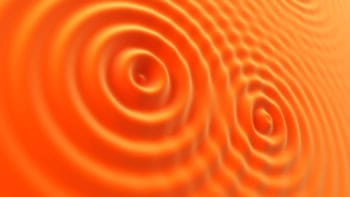
A third gravitational wave has been detected by physicists working on the LIGO gravitational-wave detectors in the US. The wave was produced by two black holes that merged about 3 billion light-years from Earth. One black hole was 31 times more massive than the Sun and the other weighed in at 19 solar masses. The previous two sightings of gravitational waves were also produced by black-hole mergers, but LIGO researchers think this is the first event in which the spin of one of the merging black holes could have been pointing in the opposite direction to the orbital rotation of the black holes.
The latest gravitational-wave observation is also the furthest of the three black-hole mergers seen so far, with the first and second detections being 1.3 and 1.4 billion light-years away, respectively. The newly observed merger created a black hole of 49 solar masses, which sits nicely between the first detection (62 solar masses) and the second (21 solar masses). Before LIGO saw its first gravitational waves in 2015, astronomers had no idea that such solar-mass black holes existed in the universe.
The new event, dubbed GW170104, was observed on 4 January 2017 when signals lasting about one tenth of a second were recorded in LIGO’s two detectors in Washington and Louisiana, which are giant interferometers, each consisting of two perpendicular arms 4 km long. Laser light travels back and forth between mirrors at either ends of the arms and some of this light is sent to a detector, where interference occurs. When a gravitational wave passes through a LIGO detector, it can slightly stretch one arm and compress the other, thereby altering the measured interference and letting the gravitational wave be measured in real time.
Death spiral
The newly observed event began as two black holes neared each other in a death spiral. As the system rotates, it broadcasts gravitational waves that spread out across the cosmos – some reaching Earth. The signals at both Livingston and Hanford had the characteristic “chirp” and “ringdown” seen in the previous two detections. Chirp describes the rapid increase in the frequency and amplitude of the gravitational wave that occurs just before the black holes merge. Ringdown is the gravitational wave that is emitted by the non-spherical merged black hole as it relaxes to become a sphere.
By studying both the chirp and the ringdown, LIGO physicists worked out the masses of the two initial black holes as well as the mass of the merged object. The merged black hole weighed 49 solar masses – the difference being radiated away in the form of gravitational waves.
Spinning around
Another key piece of information that can be gleaned from the gravitational wave is the alignment of the intrinsic angular momenta (or spins) of the black holes. As well as orbiting each other, each black hole can be spinning on its own axis – much like the Earth does. When the black holes coalesce, the total rotational velocity of the merged black hole cannot exceed a certain upper limit. So if the spins of the two merging black holes point in the same direction as the orbital spin, some of the orbital angular momentum must be discarded to meet this criterion before the merger can occur. This is done by emitting additional gravitational waves before the merger.
Data from the first detected black-hole merger (GW150914), recorded in 2015, suggested that the spins of both black holes were aligned with the orbital angular momentum. In the second detection (GW151226), recorded last year, there is some evidence that the spin of one of the black holes could be at an angle to the orbital angular momentum – but still have a component in the direction of the orbital angular momentum. In GW170104, however, it is possible that the spin of at least one of the black holes is at an angle and has a component in the opposite direction to the orbital angular momentum.
According to Bangalore Sathyaprakash of the University of Cardiff in the UK, the relative orientations of the spin and orbital angular momenta of a binary black hole provide important information about how the system formed. If they are aligned, it is likely that the system developed in isolation as two large stars that then collapse to create a binary black hole. Misalignment suggests that the black holes formed separately and then came together to create a binary system.
Real statistics
“We’re starting to gather real statistics on binary black-hole systems,” says Keita Kawabe of Caltech, who is based at the LIGO Hanford Observatory. “That’s interesting because some models of black-hole binary formation are somewhat favoured over the others even now and, in the future, we can further narrow this down.”
This third observation has also allowed LIGO scientists to put further limits on models that modify Albert Einstein’s general theory of relativity. Einstein predicts that the speed of a gravitational wave through empty space is independent of the frequency of the wave. So any deviation from this constancy would therefore show up as a frequency-dependent distortion of gravitational-wave signals seen by LIGO. Given that this was not seen, despite the waves travelling such long distances through the cosmos, general relativity appears to be holding firm.
“It looks like Einstein was right – even for this new event, which is about two times farther away than our first detection,” says LIGO physicist Laura Cadonati of Georgia Tech. “We can see no deviation from the predictions of general relativity, and this greater distance helps us to make that statement with more confidence.”
GW170104 is the first gravitational-wave detection to be announced since LIGO began its current observational run in November 2016. The LIGO team has also identified six other candidate events during this run, which they are now analysing. The observation is reported in Physical Review Letters.
- The ability to observe gravitational waves heralds a new era of astronomy in which scientists will combine observations from a number of different instruments. You can read more in Multimessenger Astronomy by Imre Bartos and Marek Kowalski



